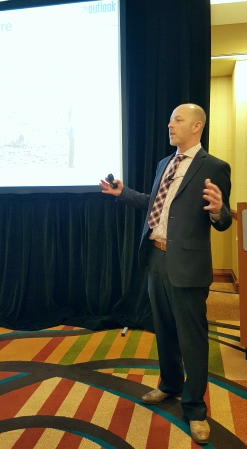ATA outlines new rules for transportation of food during Omnitracs Outlook 2017
PHOENIX, Az. – Amendments to the US’s 2011 Sanitary Transportation of Human and Animal Food rule are set to kick in later this year, with many of the guidelines having a direct effect on trucking companies that transport food across the country.
Sean Garney, director of safety policy for the American Trucking Associations (ATA), outlined these changes during Omnitracs Outlook 2017, highlighting several provisions the ATA advocated for on behalf of the industry.
One of the main areas of concern was the matter of food temperature, and what that means in terms of whether a shipment is considered to be ‘adulterated’ and destined for the dump.
Garney said the ATA stressed to the government that there are two types of temperature control – those that are deemed for safety, such the shipping of chicken, and those for quality, such as for food items like lettuce.
Food temperature control for safety has a direct effect on the public’s health, as eating contaminated chicken can cause severe illness or even death. On the other hand, food temperature for quality, where there is not health risk, is something the ATA said should be kept between the shipper and receiver.
A significant change to the 2011 rule is that requirements for recording temperatures will be left to the shipper’s discretion and the term ‘adulteration’ has been replaced by a ‘see something, say something approach, meaning if there is a possible issue with a shipment, an expert will be brought in to check the quality of the load.
“This is based on the safety of the food, not what happened during transit,” Garney said.

Recordkeeping was another focus area for the ATA.
Garney said the approach of having a ‘roomful of recordkeeping’ was onerous, and was not the best fit for the trucking industry.
“You cannot fit the trucking industry into a box,” he said. “It’s huge…they all have different requirements…every commodity is different.”
Ultimately, companies must document that they know what they are doing when shipping human and animal food.
Keeping the trailer that is transporting food sanitary is another emphasis of the new rule and brought about the change that sanitary transportation requirements are to be based on the intended use of the vehicle and on the production stage with which the food is in (raw or finished).
The rule also states that the vehicle and transportation equipment being used to move the food must be made from material that can be adequately cleaned and sanitized.
“Does anyone know what ‘adequately cleaned and sanitized’ means?” Garney asked those in attendance, referring to the broad requirements of the new rule. “Neither does the government.”
Food must also be stored in a manner to prevent pests or contamination, and temperature control systems must be designed, maintained and equipped to provide proper temperature control.
Those exempt from these new rules include ‘very small businesses’ with less than $500,000 in annual revenue, food transshipped through the US, food located in a facility already regulated by the USDA and farms performing transportation operations.
Food completely enclosed by a container that is not temperature controlled, compressed food gases, human food byproducts used for animal feed not subject to further processing and live animals are also not covered in the new rules.
Overall, Garney said the new rules gives flexibility back to the industry and shippers will be responsible for most of the new requirements.
The compliance date for large companies is April 6, with small businesses (less than 500 employees or less than $27.5 million in annual receipts) get an additional two years.
The 2011 Sanitary Transportation of Human and Animal Food, which is part of the Sanitary Food Transportation Act and section of the Food Safety Modernization Act, effects all food traveling by land and not loads shipped by sea or air.
Have your say
This is a moderated forum. Comments will no longer be published unless they are accompanied by a first and last name and a verifiable email address. (Today's Trucking will not publish or share the email address.) Profane language and content deemed to be libelous, racist, or threatening in nature will not be published under any circumstances.